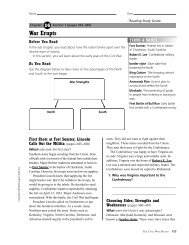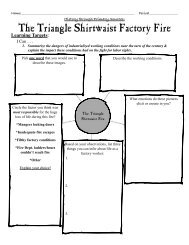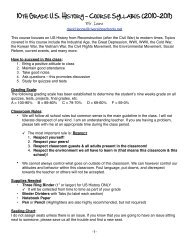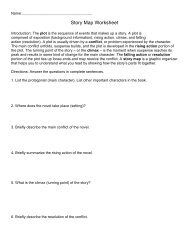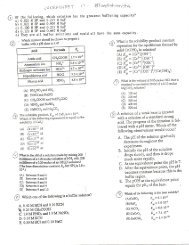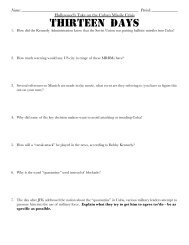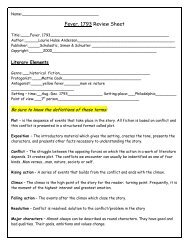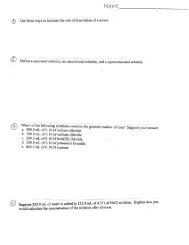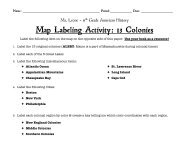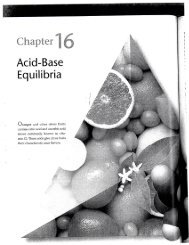Double Replacement Reactions and Solubility
Double Replacement Reactions and Solubility
Double Replacement Reactions and Solubility
- No tags were found...
Create successful ePaper yourself
Turn your PDF publications into a flip-book with our unique Google optimized e-Paper software.
Page / - <strong>Double</strong> <strong>Replacement</strong> <strong>Reactions</strong> <strong>and</strong> <strong>Solubility</strong><strong>Double</strong> <strong>Replacement</strong> <strong>Reactions</strong> <strong>and</strong> <strong>Solubility</strong>Net Ionic EquationsIntroductionPrecipitation reactions, a type of double replacement reaction, are widely used to preparenew compounds <strong>and</strong> analyze their purity. Precipitation reactions occur when aqueous solutionsof ionic compounds are combined <strong>and</strong> a new ionic compound, which is insoluble inwater, is produced. The result is the formation of a precipitate, a solid which settles out ofthe solution. By carrying out a series of possible double replacement reactions <strong>and</strong> observingwhich combinations produce precipitates, we should be able to determine some generalrules of solubility for ionic compounds in water.Concepts• <strong>Double</strong> replacement reactions• Net ionic equations• Molecular equations• <strong>Solubility</strong> rulesBackground<strong>Double</strong> replacement reactions occur when two ionic compounds (or compounds that breakapart to form ions in aqueous solution) exchange ions to form new compounds. <strong>Double</strong>replacement reactions generally occur in one direction only in response to a "driving force,"which provides a reason for the reaction to occur. Two important driving forces for reactionsbetween ions in aqueous solution are formation of a solid (precipitation reactions) <strong>and</strong> formationof a gas or stable molecular product (acid-base neutralization reactions). In the absenceof a driving force, ionic compounds will remain dissolved in solution <strong>and</strong> no chemical reactionwill take place among the dissolved ions.When an ionic compound dissolves in water, the crystalline solid dissociates or separatesinto its corresponding cations <strong>and</strong> anions. For example, silver nitrate dissociates into silvercations <strong>and</strong> nitrate anions (Equation 1).AgN03(s) - Ag+(aq) + N03^(aq) Equation 1When solutions containing two ionic compounds are mixed, two new combinations ofcations <strong>and</strong> anions are possible. In some cases, the cation from one compound <strong>and</strong> the anionfrom the other compound may combine to form an insoluble product, which is called a precipitate.For example, when sodium bromide is added to a solution of silver nitrate, there arefour different ions present <strong>and</strong> two new combinations of cations <strong>and</strong> anions—sodium nitrate<strong>and</strong> silver bromide—are possible. Sodium nitrate is soluble in water <strong>and</strong> its ions remain dissolvedin solution. Silver bromide is insoluble in water <strong>and</strong> precipitates from solution as asolid (Equation 2).AgNO,(aq) + NaBr(aq) -* AgBr(s) + NaN03(aq) Equation 2<strong>Double</strong> <strong>Replacement</strong> <strong>Reactions</strong> <strong>and</strong> <strong>Solubility</strong>
Page 3 - <strong>Double</strong> <strong>Replacement</strong> <strong>Reactions</strong> <strong>and</strong> <strong>Solubility</strong>Pre-Lab Questions1. Read the entire Procedure, including the Safety Precautions. Which solutions used inthis experiment are described as skin <strong>and</strong> eye irritants? What does this mean? What precautionsare used to protect against these hazards?2. Solutions of calcium, zinc, <strong>and</strong> lead nitrate were mixed pairwise with sodium iodide, sodiumsulfate, <strong>and</strong> sodium chromate using the procedure described in this experiment (seethe following table of results). Write a molecular equation <strong>and</strong> a net ionic equation foreach double replacement reaction that produced a precipitate.•Calcium Nitrate,Ca(N03)2Lead Nitrate,Pb(NO3)2Zinc Nitrate,Zn(NO3)2Sodium Chromate, Na2Cr04PPTPPTPPTSodium Iodide, NalNRPPTNRSodium Sulfide, Na2SNRPPTPPT3. What are the advantages <strong>and</strong> disadvantages of using molecular equations, complete ionicequations, <strong>and</strong> net ionic equations to describe double replacement reactions?MaterialsAnion Testing Solutions, 0.1 MSodium carbonate, Na2C03, 3 mLSodium chloride, NaCl, 3 mLSodium hydroxide, NaOH, 3 mLSodium iodide, Nal, 3 mLSodium phosphate, Na3P04, 3 mLSodium sulfate, 3 mLEquipmentCotton swabsDistilled water <strong>and</strong> wash bottleLabels, adhesive, 14Paper towelsCation Testing Solutions, 0.1 MAluminum nitrate, A1(N03)3, 2 mLAmmonium nitrate, NH4N03, 2 mLBarium nitrate, Ba(N03)2, 2 mLCalcium nitrate, Ca(N03)2, 2 mLCopper(II) nitrate, Cu(N03)2, 2 mLIron(III) nitrate, Fe(N03)3, 2 mLSilver nitrate, AgN03, 2 mLZinc nitrate, Zn(N03)2, 2 mLPipets, thin stem, 14Pipet holder (24-well plate)Reaction plate, 96-wellToothpicksSafety PrecautionsAmmonium nitrate, barium nitrate, copper(H) nitrate, <strong>and</strong> silver nitrate solutions areslightly toxic by ingestion. Silver nitrate, sodium carbonate, <strong>and</strong> sodium hydroxide solutionsare skin <strong>and</strong> eye irritants; silver nitrate will also stain skin <strong>and</strong> clothing. Avoid contactof all chemicals with eyes <strong>and</strong> skin. Wear chemical splash goggles <strong>and</strong> chemical-resistantgloves <strong>and</strong> apron. Wash h<strong>and</strong>s thoroughly with soap <strong>and</strong> water before leaving the lab.<strong>Double</strong> <strong>Replacement</strong> <strong>Reactions</strong> <strong>and</strong> <strong>Solubility</strong>
<strong>Double</strong> <strong>Replacement</strong> <strong>Reactions</strong> <strong>and</strong> <strong>Solubility</strong> - Page 4ProcedurePreparationSteps 1-4 may only need to be done once by the first class section doing the experiment.1. Obtain 14 thin stem pipets <strong>and</strong> 14 blank labels. Using a permanent marker or wax pencil,write the names of the 14 solutions listed in the Materials section on the labels. Write ononly one-half of each label—the labels will be folded in half around the pipets.2. Fold the labels in half around the pipet stems just above the bulbs, as shown in Figure la.3. Cut the stem of each pipet at a 45° angle about 5 cm from the bulb (Figure la). Theshorter stems will make it easier to deliver uniform-size drops.4. Fill each pipet with the appropriate solution <strong>and</strong> store the filled pipets stem-side-up in the24-well plate, as shown in Figure Ib.5. Place a clean 96-well reaction plate on top of a sheet of black paper as shown below. Eachwell is identified by a unique combination of a letter <strong>and</strong> a number—horizontal rows areidentified by the letters A-H <strong>and</strong> vertical columns are numbered from 1 to 12 {Figure 2).Figures la <strong>and</strong> Ib.1 2 3 4 5 6 7 8 9 10 11 12A OOOOOOOOOOOOB OOUOUOUOUOUOc aOUODUOUODDDDE ao'oouououoooouaououououoF ODUDDDOUOUQOG aouoouaouqqoH oououououoooFigure 2. Lettering <strong>and</strong> Numbering in a 96-Well Plate.Flinn ChetnTopic7" Labs — Chemical <strong>Reactions</strong>
Page 5-<strong>Double</strong> <strong>Replacement</strong> <strong>Reactions</strong> <strong>and</strong> <strong>Solubility</strong>Precipitation <strong>Reactions</strong>6. Place 4-5 drops of aluminum nitrate solution, the first "cation testing solution,"Al(N03)3, into well Al. Hold the pipet vertically to ensure uniform drops. Continue adding4-5 drops of aluminum nitrate solution to the next five wells in column 1 (wells B1-F1).7. Using the data table as a guide, place 4-5 drops of the appropriate "cation testing solution"into the first six wells in each vertical column 2-8 (ammonium nitrate into wells A2-F2,barium nitrate into wells A3-F3, etc.). Note: Consult the data table frequently <strong>and</strong> carefullyread each label to avoid filling wells with the wrong solution.8. Add 4-5 drops of sodium carbonate solution, the first "anion testing solution," Na2C03,into well Al.9. If a precipitate forms or the mixture appears cloudy, write PPT in the correct circle in thedata table. If no precipitate forms, write NR (no reaction) in the circle. Remember thatnot all pairs of solutions will react, <strong>and</strong> that sometimes the precipitate may take a minuteto develop. Use a clean toothpick to stir the mixture if the result is not obvious.10. Continue adding sodium carbonate solution to each filled well in row A (wells A2-A8).When all of the mixtures have been made, go back <strong>and</strong> record any evidence of reaction ineach well as PPT or NR, as described in step 9.11. In the same manner, add the appropriate "anion testing solution" to each filled well in itsrow, as shown in the data table (sodium chloride to wells B1-B8, sodium hydroxide towells C1-C8, etc.) Note: Consult the data table frequently <strong>and</strong> carefully read each label toavoid filling wells with the wrong solution.12. Record any evidence of reaction in each well as PPT or NR. If there is any doubt about theobservations in any well, repeat that test in an empty well on the reaction plate.Disposal13. Some of the transition metal <strong>and</strong> other heavy metal salts used in this experiment shouldnot be discarded into the water supply. Dump the contents of the 96-well reaction plateonto folded paper towels <strong>and</strong> discard the used paper towels in the wastebasket.14. Use cotton swabs to clean out any remaining residues in the reaction plate. Thoroughlyrinse the reaction plate several times with distilled water.<strong>Double</strong> <strong>Replacement</strong> <strong>Reactions</strong> <strong>and</strong> <strong>Solubility</strong>
<strong>Double</strong> <strong>Replacement</strong> <strong>Reactions</strong> <strong>and</strong> <strong>Solubility</strong> - Page 6Name:Data TableClass/Lab Period:<strong>Double</strong> <strong>Replacement</strong> <strong>Reactions</strong>oS"to"CQOAl A2 A3 A4 A5 A6 A7 A83UO2;Na2CO3Bl B2 B3 B4 B5 B6 B7 B8NaClCl C2 C3 C4 C5 C6 C7 C8NaOHDl D2 D3 D4 D5 D6 D7 D8NalElE2 E3 E4 E5 E6 E7 E8Na3P04FlF2 F3 F4 F5 F6 F7 F8Na2SO4Flinn ChemTopic7" Labs — Chemical <strong>Reactions</strong>
Page 7-<strong>Double</strong> <strong>Replacement</strong> <strong>Reactions</strong> <strong>and</strong> <strong>Solubility</strong>Post-Lab Questions (Use a separate sheet of paper to answer the following questions.)1. For each combination of an anion <strong>and</strong> cation testing solution that produced a precipitate,write the name <strong>and</strong> formula of the solid product. Hint: Recall that all sodium salts <strong>and</strong> allnitrate salts are soluble. Remember to balance the positive <strong>and</strong> negative charges in theformulas of the products.2. Write both a balanced molecular equation <strong>and</strong> a net ionic equation for each precipitationreaction observed in this experiment.3. (a) Which anion testing solutions produced the fewest (5) precipitates?(b) Salts of these anions may be described as insoluble with only a few exceptions. Namethe cations that are exceptions to the rule for each anion identified in 4a.5. Although you did not test the bromide (Br~) anion, would you expect most bromide salts(AlBr3, NH4Br, BaBr2, etc.) to be soluble or insoluble? What is the likely exception to thisrule? Hint: Use the periodic table to see which of the anions you tested would behave likebromide.6. Complete the following table to summarize the general solubility rules of ionic compounds.1\vo entries have been filled in for you.Ionic CompoundsSoluble or InsolubleExceptionsCarbonatesChlorides, Bromides, <strong>and</strong> IodidesHydroxidesNitratesSolubleNonePhosphatesSulfatesAlkali Metal Salts (Na+, K+, etc.)SolubleNoneAmmonium Salts<strong>Double</strong> <strong>Replacement</strong> <strong>Reactions</strong> <strong>and</strong> <strong>Solubility</strong>



